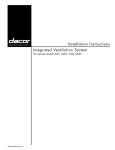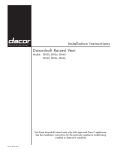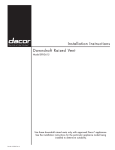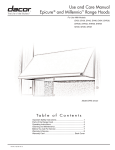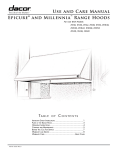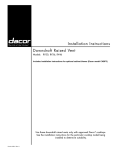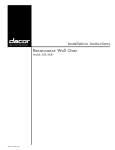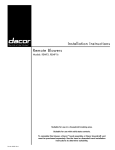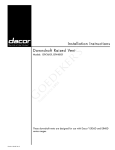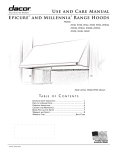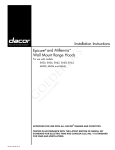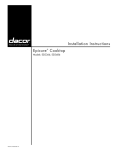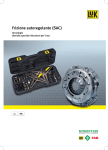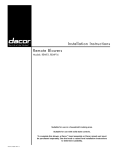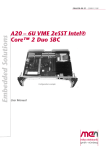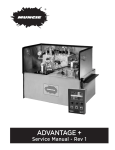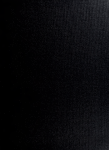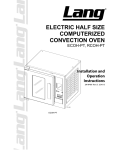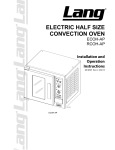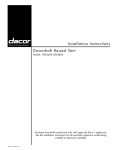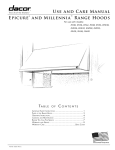Download Dacor EHR4818 Product specifications
Transcript
Installation Instructions Epicure®Wall Mount Range Hood with Remote Blower For use with models: EHR30, EHR36, EHR42, EHR48, EHR54 APPROVED FOR USE WITH ALL DACOR ® RANGES AND TESTED IN ACCORDANCE WITH THE LATEST EDITION STANDARD FOR ELECTRIC FANS AND CAN/CSA-C22.2 FOR FANS AND VENTILATORS. PartNo. 103781 Rev. D COOKTOPS. OF ANSI/UL 507 NO. 113 STANDARD Important Safety Instructions .......................................... Important Information About Safety Instructions .............. General Safety Precautions ............................................. Product Specifications .................................................... General Specifications ..................................................... Dimensions ...................................................................... Product Specifications ..................................................... Parts List .......................................................................... Planning the Installation ................................................... Cabinet Layout ................................................................. Power Supply ................................................................... 1 1 2 3 3 4 5 5 6 6 6 Preparing for Installation .................................................. Verify the Package Contents ............................................ Mounting Location Preparation ........................................ Electrical Service Installation ........................................... Duct Cutout ...................................................................... Installation Instructions .................................................. AHT10 Transition Kit Installation .................................... Mounting Bracket Installation .......................................... Hanging the Range Hood .............................................. Duct Work Installation .................................................... Final Electrical Installation ............................................. Verifying Proper Operation ............................................. Installation Checklist ...................................................... Wiring Diagrams .............................................................. 8 8 8 9 9 10 10 11 12 12 12 15 15 16 Important: • Installer: In the interest of safety and to minimize problems, read these installation instructions completely and carefully before you begin the installation process. Leave these installation instructions with the customer. • Customer: Keep these installation instructions for future reference and the local electrical inspector's use. If You Need Help... If you have questions or problems with installation, contact your Dacor dealer or the Dacor Customer Service Team. For repairs to Dacor appliances under warranty call the Dacor Distinctive Service line. Whenever you call, have the model and serial number of the appliance ready. The model and serial number are printed on the appliance data plate. Dacor Customer Service Team Phone: (800) 793-0093 (U.S.A. and Canada) Monday -- Friday 6:00 A.M. to 5:00 P.M.Pacific Time Web site: www.Dacor.com Dacor Distinctive Service (for repairs under warranty only) Phone: (877) 337-3226 Monday -- Friday 6:00 a.m. to 4:00 p.m. Pacific Time Appliance All specifications Data Plate • The appliance data plate contains the model and serial number information and the electrical requirements. • It is located inside the hood behind the filters on the back side of the chassis. Remove the filters to view it. subject to change without notice. Dacor assumes no liability for changes to specifications. © 2008 Dacor, all rights reserved. Important Information About Safety Instructions Safety Symbols and Labels [] The Important Safety Instructions and warnings in these instructions are not meant to cover all possible problems and conditions that can occur. Use common sense and caution when installing, maintaining or operating this or any other appliance. • DANGER Immediate hazards that WILL resu t n severe pers0n a injury or death ........................... [_ I WARNING Hazards 0r Unsafe practices that COULD result in severe personal injury or death. Always contact the Dacor Customer Service Team about problems and conditions that you don't understand. CAUTION Hazards Or Unsafe practices that COULD result in minor rsonal injury or property damagel [_ DANGER To avoid the PoSsibilitY Of explosion 0r fire, do not store or use combustible, flammable or explosive Vapors and liquids (such as gasoline ) inside 0rin the vicinity ofthi s or any other appliance. AIs0 keep items that could explode, such as aerosol cans away from cooktop burners, ovens and range hoods. Do not store flammable or explosive materials in adjacent cabinets or areas. WARNING If the information this manual is not followed exactly, a fire or explosi0n may result causing property damagei personal injury or death .................................................................. WARNING to prevent power from being switched on accidentally. When the service disconnecting means cannot be locked, securely fasten a prominent warning device, such as a tag, to the service panel. WARNING WARNING - TO REDUCE THE RISK OF FIRE, ELECTRIC SHOCK, OR INJURY TO PERSONS. OBSERVE THE FOLLOWING: a) Installation work and electrical wiring must be done by qualified person(s) in accordance with all applicable codes and standards, including fire-rated construction. b) Sufficient air is needed for proper combustion and exhausting of gases through the flue(chimney) of fuel burning equipment to prevent back drafting. Follow the heating equipment manufacturer's guideline and safety standards such as those published by the National Fire Protection Association (NFPA), and the American Society for Heating, Refrigeration and Air Conditioning Engineers (ASHRAE), and the local code authorities c) When cutting or drilling into wall or ceiling, do not damage electrical wiring and other hidden utilities. d) Ducted fans must always be vented to the outdoors. READ AND SAVE THESE INSTRUCTIONS _mCD_ 1 I [_ CAUTION Forgenera Vent atng UseOn y.Do notuse toexhausthazardous or exp Os ve matera sand Vaporsl General Safety Precautions To reduce the risk of fire, electric shock, serious precautions, including the following: injury or death when using your appliance, follow basic safety WARNING • Do not. install or operate this hood if it has been damaged, dropped, has damaged electrical wires or is not working properly. If the product is damaged when received, immediately contact the dealer or builder. • This range hood must be installed and grounded by a qualified installer according to these installation instructions. • Install or locate this appliance only in accordance with these installation instructions and the requirements specified by the manufacturer of the cooktop or range. Improper installation, adjustment, alteration, service or maintenance can cause serious personal injury or property damage. • TO REDUCE THE RISK OF FIRE, USE ON_Y METAL DUCTWORK. • The customer should not install, repair or replace any part of the range hood unless specifically recommended in the literature accompanying it. A qualified service technician should perform all other service. Contact the nearest Dacor authorized service representative at (800) 793-0093, or at www.Dacor.com for examination, repair or adjustment • Keep all packaging materials away from children. Plastic bags can cause suffocation. • Do not use an extension cord or adapter plug with this appliance. • The installer must show the customer the location of the fuse box or circuit breaker panel box so that the customer knows where and how to turn the power off. • Before installing or servicing the range hood, switch power off at the fuse box circuit breaker and lock the electrical panel door to prevent power from being switched on accidentally. When the electrical panel cannot be locked, securely fasten a prominent warning device, such as a tag, to the electrical panel. • Read the use and care manual completely before using the appliance. Clean the appliance only as instructed in the use and care manual. Use only the cleaners specified. • Do not tamper with the controls. • Never allow the filter(s) to become blocked or clogged. Do not allow foreign objects, such as cigarettes or napkins, to be sucked into the hood. • Clean the filter(s) and all grease-laden • If the cooktop and range hood are near a window, use an appropriate window treatment. Avoid long drapes or other window coverings that could blow over the cooktop and hood, resulting in a fire hazard. • Always run the fan(s) whenever the cooktop is operating. surfaces often to prevent grease fires and maintain performance Never leave the range or cooktop unattended when a burner (or element) is in use. Boil-overs and greasy spills may smoke and/or ignite. 2 • Do not leave children alone or unattended in the area where the cooktop and range hood are in use. Never allow children to sit or stand on an appliance. Do not let children play with a range, cooktop or range hood. Do not store items of interest to children above or around the cooktop, range or range hood. • The minimum vertical distance between the cooktop surface and the exterior part of the hood must be no less than 30" (76.2 cm). The vertical distance may be longer for the range or cooktop being used. Consult the range or cooktop installation instructions for the minimum and maximum vertical distance from the appliance being used. _mC_ General Specifications All Models Fan Speeds Filters Exhaust(s) Weight Specifications 4 Mesh type, dishwasher safe 8-inch Total Connect Load 120 Vac, 60 Hz, 6.5Amp. Lights Max. 120 Vac, 75 W halogen Model Specific Model Number Lights Filters Exhaust Outputs EHR48 EHR54 EHR42 EHR30 EHR36 3 2 2 4 3 2 2 1 Model Weight EHR3012 39 Ibs. (18 kg) EHR3018, EHR3612 44 Ibs. (20 kg) EHR3618 48 Ibs. (22 kg) EHR4212 46 Ibs. (21 kg) EHR4218 51 Ibs. (23 kg) EHR4812 52 Ibs. (24 kg) EHR4818 59 Ibs. (27 kg) EHR5418 66 Ibs. (30 kg) _mCD_ 3 Dimensions Tolerances: +1/16",-0 (1.6 mm,-0), unless otherwise stated. NOTE: The exhaust duct(s) and electrical wiring can be connected from either the top or the back of the hood. Dual exhaust models* Standard 8" duct connection Single exhaust models** Standard 8" duct connection M Electrical access holes 7/8" Dia. (5.1 cm) _ ,I" [ % / _" \ I ! + \ II / I \ I! + + I \ \ I I I / I \ S l Front of hood 6 1/8" (15.6 cm) / % S II f _-- 9 7/8" "-_ (25.1 cm) 1 ½" (3.8 cm) 4" (10.2 cm) I 3" (7.6 cm) 19¾" (50.2 cm Top Dimensions 19¾" (50.2 cm 3" (7.6 cm) / 4" (10.2 cm) ¾,, (1_9 cm) i_1 ._ | 9 7/8" --_ (25.1 cm) ' D I I / Electrical access holes 7/8" Dia. (5.1 cm) / Bottom of hood _\ I / _'\ l I I 1 \ I I iI \ l ! + \ Dual exhaust models* Standard 8" duct connection l I l I I I l + \ I f I / Single exhaust models** Standard 8" duct connection Back Dimensions * Models EHR48, EHR54 ** All other models *** See facing page 4 _mC_ *** OVERALL 11 (30.2 cm) Model A EHR3012 29 7/8" (75.9 cm) EHR3612 DIMENSIONS B C D_ 35 7/8" (91.1 cm) 26 7/8" 12 3/8" 4 1/2" EHR4212 41 7/8" (106.4 cm) (68.3 cm) (31.4 cm) (11.4 cm) EHR4812 47 7/8" (121.6 cm) EHR4218 41 7/8" (106.4 cm) EHR3018 29 7/8" (75.9 cm) EHR3618 35 7/8" (91.1 cm) EHR4818 26 7/8" (68.3 cm) 18" (45.7 cm) 6 1/8" (15.6 cm) 47 7/8" (121.6 cm) EHR5418 53 7/8 (136.8 cm) *** See diagram on facing page. Overall Dimensions (5.1 cm) (34.9 cm) 32" (81.3 cm) Dimensions of Optional AHT10 Transition For dual exhaust models, See page 7 for more information 9 _ (22.9 cm) 3_ (1.9 cm) Parts List D Hood assembly with filters (size and style varies with model) D 2 temporary mounting brackets D Temporary mounting hardware D Light replacement tool iterature Light bulbs (quantity varies with model) Dacor Stainless Steel Cleaner ii _mCD_ 5 [_ WARNING I observe all g0verning c0des and ordinances during planning and installationl Contact y0ur local building department further informati0nl Cabinet Layout [_ [_ for I I IMPORTANT See the diagram for minimum installed distance from the hood t0 the co0ktop surfacel The minimum specified distance maybe higher for the particular range or cooktop in use: Check the manufacturers specifications for the €ooktop or rangel WARNING To reduce the risk of personal injury caused by reaching over a hot appliancel cabinet storage space located directly above the range should be avoided. Carefully check the location where the hood is to be installed. The hood should be placed for convenient access. Make certain that electric power can be provided in the selected location. The hood must be centered horizontally over the cooktop/range. • The hood model selected must be as wide as the cooktop surface or wider. • Plan the installation so that all minimum dimensions are met or exceeded. Dimensions shown provide minimum clearances, unless otherwise noted. • All contact surfaces between the hood and any cabinets or walls must be solid and at right angles. • Install the range hood and cooking appliance(s) so that they can be removed if service is required. Power Supply 25" Min. • (63.5 cm) [_ WARNING The electric service to the rang e h00d Sh0U only by a licensed electrician. I nsta ed ................. It is the owner's responsibility to ensure that the electrical connection of this appliance is performed by a qualified electrician. The electrical installation, including minimum supply wire size and grounding, must be in accordance with the National Electric code ANSI/NFPA* (or latest revision) and local codes and ordinances. © *A copy of this standard may be obtained from: National Fire Protection Association 1 Batterymarch Park Quincy, Massachusetts 02269-9101 • The ground terminal on the hood must be connected to a grounded, metallic, permanent wiring system or grounding conductor installed by a licensed electrician. • Do not ground the appliance or appliance wiring to a gas pipeline or to the neutral (white) power supply wire. MINIMUM CABINET WIDTH Models E EHR3012, EHR3018 30" (76.2 cm) EHR3612, EHR3618 36" (91.5 cm) EHR4212, EHR4218 42" (106.7 cm) EHR4812, EHR4818 48" (121.9 cm) EHR5418 54" (137.2 cm) All tolerances: +1/16", -0, unless otherwise stated 6 _mC_ Do not install a fuse in the neutral or ground circuit. Connect the hood directly to an electrical junction box. Hard-wire the hood according to local code directly to a dedicated three wire grounded, single phase circuit rated at 120 Vac 60 Hz, 15 Amp. [_ • The customer must supply conduit with minimum current carrying capacity of 8 Amps to supply power to the remote blower from the hood. WARNING To prevent combustion by-products, smoke or odors from entering the home and to improve efficiency, tape all duct joints securely. • Use only duct work deemed acceptable by state, municipal and local codes. • Range hoods may interrupt the proper flow of smoke and combustion gases from furnaces, gas water heaters and fireplaces. To avoid drawing lethal gases into the home, follow the manufacturer's recommendation for these devices and consult NFPA and ASHRAE recommendations. All duct work materials (including screws and duct tape) must be purchased separately by the customer. The hood exhaust connects to an 8-inch round duct. You can increase the duct size over the duct run if desired. To prevent a back draft, never decrease the duct size over the run. If existing duct work is smaller than 8 inches in diameter, remove it and replace it with 8-inch duct work. Do not rely on tape alone to seal duct joints. Fasten all connections with sheet metal screws and tape all joints with certified silver tape or duct tape. Use sheet metal screws as require to support the duct weight. Failure to install a remote blower or proper duct work may result in a back draft and/or the insufficient venting of smoke and fumes. DO NOT install more than one in-line or external blower to increase the length of the duct run. Even small differences between blower air flow rates can greatly reduce the air draw by the hood. [_ • Make sure duct work does not interfere with floor joists or wall studs. • On dual exhaust models, the two 8" exhausts may be merged into one 10" duct using Dacor transition kit AHT10. See page 10 for details. • When planning new duct work, always look for the shortest, most direct route to the outside. The duct collar can be moved to accommodate venting (and wiring) through the top [] or the back I="11. CAUTION To reduce the risk Of fire and to properly exhaust air, be sure to duct air outside the house or building, Do not vent exhaust air into spaces within walls or ceilings or into attics, crawl spaces or garages. ............... • To prevent back-drafts, a damper at the duct outlet may also be required. Remote The ventilation system consists of hood and a single remote or single in-line blower. A Dacor remote or in-line blower must be installed for the hood to operate properly. Only one blower shall be installed. / Blower Conduit The EHR series hoods cannot be installed with any other blower type than the models indicated below. For directions on installing the blower, see the REMP3/16, ILHSF8/10 installation instructions. Conduit .... Remote ::iiiiiiiiiiii Tar APPROVED DACOR BLOWERS FOR USE WITH EHR SERIES HOODS Model REMP3* (remote) 600 CFM ILHSF8* (in-line) 600 CFM REMP16* (remote) 1000 CFM ILHSF10* (in-line) 1200 CFM EHR30/36/42 X X X X X X EHR48/54 At 0 inches static pressure Wire the remote blower to turn on. The vent is turned on by running a piece of conduit parallel to the duct work and connecting it to the hood on one end and the remote blower on the other. There are 7/8" access holes in the top and back of the hood for connecting the conduit. Calculating the Maximum Duct Run Length The maximum straight duct length for the hood is determined by the type of duct used. See the chart below. DUCT SIZE MAXIMUM DUCT RUN 8" round 60 feet 10" round 50 feet For each elbow and transition added to the duct work, a certain number of feet must be subtracted from the maximum duct run to compensate for wind resistance. To determine the length the duct work cannot exceed, subtract all of the equivalent lengths of the elbows and transitions listed below from the maximum duct run above. Continued... _mCD_ 7 Keep turns as far away from the hood exhaust as possible, and as much space between bends as possible. Duct Work Equivalent Lengths EQUIVALENT LENGTHS Piece Subtract Piece Subtract 8" 90° elbow 7 feet 10" 90° elbow 5 feet 8" 45° elbow 3 feet 10" 45° elbow 2 feet 3¼" X 10" to round 90° transition 25 feet 3¼" X 10"to 8'710" round transition 4 feet Roof cap , Walt cap with damper , For best performance, use round duct instead of rectangular, especially when elbows are required. If multiple elbows are used, try to keep a minimum of 24" straight duct between them. Avoid "S" or "back to back" use of adjacent elbows. In regions where the weather gets extremely cold, use thermal breaks, such as a short section of non-metallic duct, to avoid indoor heat loss. Locate the break as close as possible to the outside pass through point. The equivalent lengths of roof and wall caps vary with model and configuration. For equivalent length, contact the manufacturer or a qualified HVAC specialist. Duct Work • Design Do not use duct work that is smaller in cross-sectional area than the recommended types above. Tips Wherever possible, reduce the number of transitions and turns to as few sharp angles as possible. Two staggered 45 ° angles are better than one 90 °. Verify the Package Contents Unpack the parts box and verify that all parts have been included according to the parts list on page 5. If any item is missing or damaged, please contact the dealer immediately. Do not install a damaged or incomplete appliance. Make sure you have everything necessary for proper installation before proceeding. Mounting Location Preparation WARNING 8 Do not use flexible metal duct. • The electrical service to the range hood should be installed only by a licensed electrician. • Observe all governing codes and ordinances during site preparation and installation. Contact your local building department for further information. • Failure to properly anchor the hood to the wall may result in personal injury due to the unit falling off the wall. • To avoid an electric shock hazard and property damage, locate electric wires and water pipes and avoid drilling or cutting in the vicinity. • Use the temporary mounting brackets only to hold the hood in place until permanent anchoring is installed. _mC_ • Temporary mounting brackets, and the screws and anchors to hold them in place during installation are provided with the hood. Two anchors and screws are used per bracket. • Determine the number, size and type of anchors required to attach the hood permanently to the wall and/or the cabinets based on the type of installation and the weight chart on page 3. Make sure the mounting surface is properly reinforced to handle the full weight of the hood. If mounting the unit to a drywall or I plastered surface, install I I a reinforced mounting block between the studs behind all hood mounting locations. You may attach screws directly to the studs and cabinets if they line up with the mounting holes in the back and top of the hood. If mountI ing the hood to brick or I I masonry, select anchors capable of holding the full weight of the hood. Electrical Service Installation Back wall WARNING The e!ectric service to the range hood sh0u only by a licensed electrician. ................. I nsta e d Install a junction box in the vicinity of the hood electrical access holes according to local codes. Install it either behind or above the hood. The diagram below shows suggested locations. Drill 7/8" holes in the wall or cabinet as necessary to allow the wiring to pass through into the hood. See page 4 for hole locations. 0 Hood Location Duct Cut-Out for Rear Venting Ceiling or cabinet bottom Duct Cutout , Using a pencil, draw the vertical center line for the range hood on the wall. Extend the line down 10" (25.4 cm) from where the top of the hood will be located. The center line for the hood is usually halfway between the cabinets at the installation location or the same as the center line of the cooktop or range. The line will be used to line up the mounting brackets during installation. , , Locate the center lines for the duct cutout(s) according to the dimensions on page 4. For installations venting through the top of the hood, use the top dimensions to locate the center lines on the ceiling or cabinet bottom. For installations venting through the back of the hood, use the back dimensions to locate the center lines on the back wall. See the diagrams on the right. Cut a hole for the duct to pass through 11" (28 cm) in diameter. Center it on the center lines. Dual exhaust models require two (2) holes. O Duct Cut-Out for Top Venting _mCD_ 9 . WARNING Do not install the range hood unless the electrical service provided meets the range hood specifications. . Using the existing screws, attach the cover plate removed in step 5 to the top of the hood to cover the hole. Attach the duct collar(s) removed in step 2 to the back of the unit using the existing screws. Observe all governing codes and ordinances during installation. Contact your local building department for further information. ? A qualified technician must complete the installation of this built-in appliance. More than one person is required to raise the hood into place. The owner is responsible to make sure the hood is properly installed. 1. ° o Start by removing the filters from the bottom of the hood. Put them in a safe location so that they will not be damaged. If the hood will be installed in a top exhaust configuration, skip to AHTIO Transition Kit Installation. If the hood will be installed so that air will exhaust out of the back, the duct collar(s) must be moved to the rear before hanging the hood. 2. Place the hood assembly on a large flat surface. 3. Remove and save the duct collar screws from the top of the unit. See below. If the unit has two duct collars, remove both sets of screws. 4. Remove the duct collar(s). 5. Remove and save the cover plate screws and the cover plate(s) on the back of the hood. Duct Collar ",,,_ _ ,_ Cover Plite AHTIO Transition Kit Installation On dual exhaust models, the two 8" exhausts may be merged into one 10" duct using Dacor transition kit AHT10. Install the transition before installing the hood on the wall. It connects to the hood on the top or rear, depending on the type of installation. Preparing the AHT1 0 for Installation Prepare the transition for installation by bending the bottom edges at right angles to create a ¾" flange around the base. IMPORTANT: On 12" high hoods modified to exhaust out the rear, leave one of the long edges unbent. @-@@ O / Leave this edge unmodified, bend up other three. Transition Flange Prep: All models using top exhaust and 18" high models with rear exhaust Transition Flange Prep: 12" high models with rear exhaust Drill pilot holes around the edges of the mounting flange including the unmodified edge, if the transition will be mounted to the back of a 12" high hood (see above). 10 c_acar Installing the AHT1 0 Transition" 12" high models with rear exhaust: Top exhaust models and 18" Center the transition over the duct collars while resting the unmodified edge on the top of the hood. Fasten in place using sheet metal screws (not included). Seal the base of of the transition with duct tape. high models with rear exhaust: Center the transition over the duct collars and fasten it in place using sheet metal screws (not included). Seal the base of the transition with duct Top mounting shown tape. Mounting Bracket Installation , Draw the horizontal center line for the temporary mounting brackets on the wall. The center line for the brackets is 2 1/8" (54 cm) below where the top of the hood will be located. The horizontal line marks the center line of the mounting screws that hold the temporary mounting brackets in place. Installing the braCkets lower Or hig her than 2 !/8 problems during final installation: , Find the temporary mounting bracket in the shipping box. Put the bracket against the wall and line up the center hole with the intersection of the bracket center lines on the wall. Make sure the anchors and/or screws used are strong enough to support the hood. Make sure drywall installations are properly reinforced. Mark the two mounting hole positions through the holes in the bracket. Drill the pilot holes for the screws or anchors and attach the brackets securely to the wall. I below I the top of the final hood [_ IMPORTANT location will cause alignment ,, 2. , I ............... I Draw the two (2) vertical center lines for the brackets on the wall. They are located on both sides of the hood center line drawn on the wall before making the duct cut-out. The distance from the center line depends on the model. See the chart below. TEMPORARY BRACKET CENTER LINE DISTANCE Models F EHR3012, EHR3018 12 3/8" (31.4 cm) EHR3612, EHR3618 15 3/8" (39.1 cm) EHR4212, EHR4218 18 3/8" (46.7 cm) EHR4812, EHR4818 21 3/8" (54.3 cm) EH R5418 24 3/8" (61.9 cm) 2 1/8" I \ I I- I ÷ ,/ Bracket location I F i I I blood location -----_, i i i I I i i \ Bracket location i i Reinforced Drywall i i i i ,L ,i ctacor 11 Hanging the Range Hood [_ Reattach the hood to the temporary mounting brackets. Lift the hood into its final position and fasten it in place. back of the through hood intothe themounting studs, mounting Insert and the top fasteners slots in the WARNING Hanging the range hood requires _o people: Do not attempt to lift the hood Without assistance: 1. Remove the plastic coating from the outside of the hood. 2. Remove the filter(s) to reduce weight and avoid damage. 3. 7 8. Lift the hood up on both sides and slip the mounting slots over the tabs on the mounting brackets. i i i i blocks or anchors. Duct Work Installation [_ WARNING During duct installati0n; make sure there are n0 I obstructions that kee p the damper flaps on the top of the hood from open ng. Install the remote blower according to the remote blower installation instructions. 2. Install the duct work starting from the hood and working toward the remote blower. Observe the specifications on page 7 and 8. 3. Fasten all joints with sheet metal screws and seal with duct tape or certified silver tape. Final Electrical Installation [_ , , 6. Lift the hood into its final position and mark the desired locations for the anchors or wood screws through the mounting slots on the back and top of the hood. • To avoid electric shock or fire hazard, prior to connecting the electrical wiring to the hood, make sure that power to the hood power supply line is turned off at the fuse box or circuit breaker panel. • Improper connection of the hood electrical wiring may create an electric shock or fire hazard and may result in damage to the hood's electrical system. See page 6 for specifications. • Do not ground the hood to the neutral (white) power supply wire. Connect the hood ground wire to a separate, properly grounded wire installed by a licensed electrician. • Make sure all wire used is capable of handling the total connected load. See page 3. Remove the hood from the wall. Drill the pilot or mounting anchor holes. If using mounting anchors insert them into the mounting holes. o I I I Turn off power to the hood electrical circuit at the circuit breaker or fuse box. , , , , Mounting 12 c_acar WARNING Hole Locations Run the conduit line used to supply power from the hood to the remote blower parallel to the duct work. Wire the remote blower according to the remote blower or in-line installation instructions. Connect the conduit to the hood and route the wires to the terminal block inside the hood. Route the power supply wiring from the junction box to the hood. Feed the wiring through the wiring access holes in the hood and route them to the terminal block inside the hood. 6. Connect the wiring to the remote/in-line blower and the power supply line from the junction box as shown. _E_ Hot To remote/ in-line blower Neutral Ground _ .-_ To junction box , Connect the hood wiring to an electrical junction box on a dedicated circuit. See page 6 for specifications. Connect it according to the 3-Wire Connection to Junction Box method shown or External Ground Method shown on the following page. Hood Power Terminals To house circuit breaker panel or fuse box I Wire Nut, 3 places GREEN GREEN _""'Junction UL/CSA approved J NEMA strain relief 3 Wire Connection '_Torange to Junction Box hood Box ctacor 13 To house circuit breaker panel or fuse box Separate No. 10 (minimum) / copper ground wire I Wire Nut, 3 places Meter WHITE WHITE _[_ No. 4 copper wire GREEN GREEN _ UL/CSA approved NEMA strain relief Junction Box \ Insulated Pipe Jumper (if necessary) To range hood WARNING • i Do not ground the circuit to a gas linel Do not ground the circuit to a hot water pipe. water lines that are insulated must be jumped t0 assure continuity to ground: See above. Grounding the Hood Wiring Using an External Cold Water Pipe Light Bulb Installation 1. Attach the included suction cup to one of the provided light bulbs. 2. Insert it into one of the light fixtures. 3. Screw it into place and remove the suction cup. 4. Repeat for the remaining light fixtures. 14 =/acar Verifying Proper Operation Installation Checklist WARNING /_ _" Feature Keys _ 'X_ Main • To ensure a safe and proper installation, the following checklist should be completed by the installer to ensure that no part of the installation has been overlooked. • Proper installation is the responsibility of the homeowner. The importance of proper installation of your Dacor range hood cannot be overemphasized. [] Is the hood properly attached to the wall according to the instructions on page 12? [] Is the duct work completely installed? Are all joints attached with sheet metal screws and wrapped with duct tape? See page 12. [] Is the range hood wired and grounded according to these instructions and in accordance with all applicable electrical codes? See Page 12. [] Are the filters properly installed according to the use and care manual? [] Has proper operation been verified? [] Has the warranty been activated on-line or the warranty card been filled out completely and mailed? Switch Filters , 2. Make sure the main power switch is off. Turn on power at the circuit breaker panel or fuse box. , Turn on the main power switch. , Install the filter(s). , , , Touch the LIGHTS feature key. Verify that all the lights come on. Touch the LIGHTS key again to turn the lights to the low setting. Touch the LIGHTS key again to turn the lights off. 8. Touch the FAN feature key once and release. Verify that one light is showing on the fan speed indicator and that the fan is on at low speed. Touch and release the FAN key repeatedly, three times. Verify that with each touch of the key, the number of lights on the fan speed indicator increases and that the fan speed increases. 9. Touch the FAN key again to turn the fan off. If the hood fails to operate properly: • Verify that power is supplied to the hood. • Check the electrical connections to ensure that the installation has been completed correctly. Repeat the above test. If the hood still does not work, contact Dacor Distinctive Service at (877) 337-3226. Do not attempt to repair the appliance yourself. If you need service, be sure to have the model and serial numbers available when you call. See the inside cover for location. Do not attempt to repair the appliance yourself. Dacor is not responsible for service required to correct a faulty installation. c/mcar 15 _ i " ' I o I"1'1 -r II I"1'1 -r _o o_z m o II o I"1'1 -r C z_ OG0 :',I.__:__ . __.'.'__1 m ;;0 '' m 0 0 ITI 16 cl_car o m o 0 I-0 '.,1 z 0 3_ ;:D 0 0 r7 rY < 0 re w a 0 0 nO z 0 o LU n- I_J m-I_ z ._1 0 _ o_,,o_ w rY Iic98 _w_ w_w_ z _w "1" ILl zgO_ o _o "1" ILl 7= Ro n >o 0 I "0 0 _ L_ C ii J o')o <To O0 ILl Z ILl LLI r_ 0 0 "I- cla=ar_ 17 4# The Life of the Kitchen? Dacor • 1440 Bridge Gate Drive, Diamond Bar, CA 91765 • Tel: (800) 793-0093 • FAX: (626) 403-3130 • www.Dacor.com




















